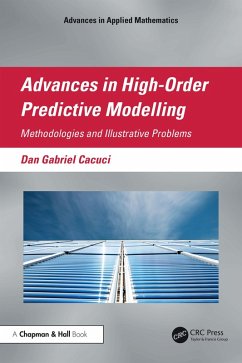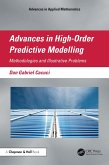Advances in High-Order Predictive Modeling (eBook, ePUB)
Methodologies and Illustrative Problems


Alle Infos zum eBook verschenken

Advances in High-Order Predictive Modeling (eBook, ePUB)
Methodologies and Illustrative Problems
- Format: ePub
- Merkliste
- Auf die Merkliste
- Bewerten Bewerten
- Teilen
- Produkt teilen
- Produkterinnerung
- Produkterinnerung

Hier können Sie sich einloggen

Bitte loggen Sie sich zunächst in Ihr Kundenkonto ein oder registrieren Sie sich bei bücher.de, um das eBook-Abo tolino select nutzen zu können.
Continuing the author's previous work on modeling, this book presents the most recent advances in high-order predictive modeling. The author begins with the mathematical framework of the 2nd-BERRU-PM methodology, an acronym that designates the "second-order best-estimate with reduced uncertainties (2nd-BERRU) predictive modeling (PM)." The 2nd-BERRU-PM methodology is fundamentally anchored in physics-based principles stemming from thermodynamics (maximum entropy principle) and information theory, being formulated in the most inclusive possible phase-space, namely the combined phase-space of…mehr
- Geräte: eReader
- mit Kopierschutz
- eBook Hilfe
![Advances in High-Order Predictive Modeling (eBook, PDF) Advances in High-Order Predictive Modeling (eBook, PDF)]() Dan Gabriel CacuciAdvances in High-Order Predictive Modeling (eBook, PDF)52,95 €
Dan Gabriel CacuciAdvances in High-Order Predictive Modeling (eBook, PDF)52,95 €![The Best Writing on Mathematics 2015 (eBook, ePUB) The Best Writing on Mathematics 2015 (eBook, ePUB)]() The Best Writing on Mathematics 2015 (eBook, ePUB)19,95 €
The Best Writing on Mathematics 2015 (eBook, ePUB)19,95 €![The Nth Power (eBook, ePUB) The Nth Power (eBook, ePUB)]() Mitchell WickThe Nth Power (eBook, ePUB)2,99 €
Mitchell WickThe Nth Power (eBook, ePUB)2,99 €![Best Writing on Mathematics 2014 (eBook, ePUB) Best Writing on Mathematics 2014 (eBook, ePUB)]() Best Writing on Mathematics 2014 (eBook, ePUB)17,95 €
Best Writing on Mathematics 2014 (eBook, ePUB)17,95 €![Best Writing on Mathematics 2011 (eBook, ePUB) Best Writing on Mathematics 2011 (eBook, ePUB)]() Best Writing on Mathematics 2011 (eBook, ePUB)13,95 €
Best Writing on Mathematics 2011 (eBook, ePUB)13,95 €![A Journey Through Math-Land (eBook, ePUB) A Journey Through Math-Land (eBook, ePUB)]() Reza NoubaryA Journey Through Math-Land (eBook, ePUB)2,99 €
Reza NoubaryA Journey Through Math-Land (eBook, ePUB)2,99 €![Fermat's Enigma (eBook, ePUB) Fermat's Enigma (eBook, ePUB)]() Simon SinghFermat's Enigma (eBook, ePUB)7,99 €
Simon SinghFermat's Enigma (eBook, ePUB)7,99 €-
-
The 2nd-BERRU-PM methodology provides second-order output (means and variances) but can incorporate, as input, arbitrarily high-order sensitivities of responses with respect to model parameters, as well as arbitrarily high-order moments of the initial distribution of uncertain model parameters, in order to predict best-estimate mean values for the model responses (i.e., results of interest) and calibrated model parameters, along with reduced predicted variances and covariances for these predicted responses and parameters.
Dieser Download kann aus rechtlichen Gründen nur mit Rechnungsadresse in A, B, BG, CY, CZ, D, DK, EW, E, FIN, F, GR, HR, H, IRL, I, LT, L, LR, M, NL, PL, P, R, S, SLO, SK ausgeliefert werden.
- Produktdetails
- Verlag: Taylor & Francis eBooks
- Seitenzahl: 302
- Erscheinungstermin: 11. Dezember 2024
- Englisch
- ISBN-13: 9781040193228
- Artikelnr.: 72275795
- Verlag: Taylor & Francis eBooks
- Seitenzahl: 302
- Erscheinungstermin: 11. Dezember 2024
- Englisch
- ISBN-13: 9781040193228
- Artikelnr.: 72275795
- Herstellerkennzeichnung Die Herstellerinformationen sind derzeit nicht verfügbar.
This is Dr. Cacuci's fifth book for CRC Press. The others include, The Second-Order Adjoint Sensitivity Analysis Methodology (2018); Computational Methods for Data Evaluation and Assimilation with Ionel Michael Navon and Mihaela Ionescu-Bujor (2013); Sensitivity and Uncertainty Analysis, Volume I Applications to Large-Scale Systems (2003) and Volume II (2005) also with Mihaela Ionescu-Bujor and Michael Navon.
.
Methodology for Reducing Uncertainties in Predicted Model Responses and
Parameters
1.1. Introduction
1.2. Generic Mathematical Modeling of a Physical System
1.3. Construction of the Minimally Discrepant Maximum Entropy Distribution
1.4. Construction of the Second-Order Minimally Discrepant Maximum Entropy
Distribution of Experimentally Measured Responses and Parameters
Practical Case 2nd-BERRU-PMP: Inclusion of Response Measurements
Inter-Comparison: 2nd-BERRU-PMP vs. 2nd-BERRU-PMD
1.7.1.
1.7.2.
1.7.3.
1.7.4. Inter-Comparison:
1.7.5. Inter-Comparison:
1.8. Review of Principles Underlying the Data Adjustment and Data
Assimilation Procedures
1.8.1. Principles Underlying the Data Adjustment Procedure
1.8.2. Principles Underlying the Data Assimilation Procedure
1.9. Discussion and Conclusions
CHAPTER 2: Application of the 2nd-BERRU-PM Methodology to the PERP Reactor
Physics Benchmark
2.1. Introduction
2.2. Mathematical Modeling of the
2.3:
2.3.1. "High precision" parameters; uniform relative standard deviations
2.3.2. "Typical precision" parameters; uniform relative standard deviations
2.3.3. "Low precision" parameters; uniform relative standard deviations
2.4: Illustrative Application of the 2nd-BERRU-PM Methodology to the PERP
Benchmark: Mathematical Expressions for the Best Estimate Predicted Mean
and Variance for the PERP Leakage Response
2.4.1. Best-Estimate Predicted Mean Value, , for the PERP Leakage Response
2.4.2. Best-Estimate Predicted Standard Deviation for PERP Leakage Response
2.5: Typical-Precision Consistent Measured Response (neutrons/sec; )
2.5.1. High-precision (3% relative standard deviations) parameters
2.5.2: Typical precision (5% relative standard deviations) parameters
2.5.3. Low precision (10% relative standard deviations) parameters
2.6: Low-Precision Consistent Measured Response (neutrons/sec; ); High
Precision Parameters (relative SD=3%)
2.7: Typical-Precision Inconsistent Measured Response ( neutrons/sec;
)
2.7.1. High-precision (2% relative standard deviations) parameters
2.7.2. Typical-precision (5% relative standard deviations) parameters
2.7.3. Low-precision (10% relative standard deviations) parameters
2.8: High-Precision Apparently Inconsistent Measured Response (
neutrons/sec; ) and High Precision Parameters (SD=3%)
2.8.1. Including Only Contributions from the 1st -Order Sensitivities of
the Leakage Response to the Total Cross Sections
2.8.2. Including Contributions from the 1st + 2nd -Order Sensitivities of
the Leakage Response to the Total Cross Sections
2.8.3. Including Contributions from the 1st + 2nd + 3rd-Order Sensitivities
of the Leakage Response to the Total Cross Sections
2.8.4. Including Contributions from the 1st + 2nd + 3rd + 4th -Order
Sensitivities of the Leakage Response to the Total Cross Sections
2.9: High-Precision Possibly Inconsistent Measured Response ( neutrons/sec;
) and Low Precision Parameters (SD=10%)
2.9.1. Including Only Contributions from the 1st -Order Sensitivities of
the Leakage Response to the Total Cross Sections
2.9.2. Including Contributions from the 1st + 2nd -Order Sensitivities of
the Leakage Response to the Total Cross Sections
2.10: Low-Precision Apparently Inconsistent Measured Response (
neutrons/sec; ); Typical Precision Parameters (SD=5%)
2.10.1. Including Only Contributions from the 1st -Order Sensitivities of
the Leakage Response to All Important Parameters
2.10.2. Including Contributions from the 1st + 2nd -Order Sensitivities of
the Leakage Response to All Important Parameters
2.10.3. Including Contributions from the 1st + 2nd + 3rd-Order
Sensitivities of the Leakage Response to the Total Cross Sections
2.10.4. Including Contributions from the 1st + 2nd + 3rd + 4th -Order
Sensitivities of the Leakage Response to the Total Cross Sections
2.11: Measured Response Value Coincides with Nominally Computed Response
Value
2.12. Concluding Remarks
CHAPTER 3: A Novel Generic Fourth-Order Moment-Constrained Maximum Entropy
Distribution
3.1. Introduction
3.2. Construction of the Fourth-Order Moment-Constrained Maximum Entropy
(MaxEnt) Representation of Uncertain Multivariate Quantities
3.3. Concluding Remarks
Appendix 3.A. Auxiliary Computations for Constructing the
Moment-Constrained Fourth-Order MaxEnt Distribution
Appendix 3.B. Approximations Inherent to the Fourth-Order Maximum Entropy
Distribution
CHAPTER 4: 4th-BERRU-PM: Fourth-Order Maxent Predictive Modeling
Methodology for Combining Measurements with Computations to Obtain
Best-Estimate Results with Reduced Predicted Uncertainties
4.1. Introduction
4.2. Construction of the Moments-Constrained Fourth-Order MaxEnt
Distribution of the Computational Model Parameters and Responses
4.3. Mathematical Framework of the 4th-BERRU-PM Methodology for Obtaining
Best Estimate Results with reduced Uncertainties
4.3.1. Best-Estimate Fourth-Order Expression of the Vector of Mean Values
of the Predicted Responses
4.3.2. Best-Estimate Fourth-Order Expression of the Vector of Mean Values
of the Predicted Calibrated Model Parameters
4.3.3. Best-Estimate Fourth-Order Expression of the Covariance Matrix of
the Predicted Responses
4.3.4. Best-Estimate Fourth-Order Expression of the Covariance Matrix of
the Calibrated Model Parameters
4.3.5. Best-Estimate Fourth-Order Expression of the Correlation Matrix of
the Predicted Responses and Calibrated Model Parameters
4.3.6. Best-Estimate Fourth-Order Expression of the Triple Correlations
among Predicted Responses and Calibrated Model Parameters
4.3.7. Best-Estimate Fourth-Order Expression of the Quadruple Correlations
among Predicted Responses and Calibrated Model Parameters
4.3.8. Indicator of Consistency among Parameters and Responses
4.4. Conclusions
Appendix 4.A. Auxiliary Computations for Constructing the Fourth-Order
Maximum Entropy Distribution for Model Parameters and Responses
5.1. Introduction
5.2. 4th-BERRU-PM Predicted Best-Estimate Posterior Mean and Variance for
the PERP Leakage Response
5.2.1. Low Precision (Standard Deviation=10%) Measurement of the Leakage
Response
5.2.1.a. "High precision" parameters (relative standard deviations )
5.2.1.b. "Typical precision" parameters (relative standard deviations )
5.2.1.c. "Low precision" parameters (standard deviations )
5.2.2. Typical Precision (Standard Deviation=5%) Measurement of the Leakage
Response
5.2.2.a. "High" precision parameters (relative standard deviations )
5.2.2.b. "Typical" precision parameters (relative standard deviations )
5.3. 4th-BERRU-PM Best-Estimate Posterior Mean Values of Calibrated Model
Parameters
5.3.1. "High" precision parameters (relative standard deviations )
5.3.2. "Typical" precision parameters (relative standard deviations )
5.4. 4th-BERRU-PM Best-Estimate Posterior Correlations Between Predicted
Responses and Calibrated Model Parameters
5.4.1. "High" precision parameters (relative standard deviations )
5.4.2. "Typical precision" parameters (relative standard deviations )
5.5. 4th-BERRU-PM Best-Estimate Posterior Covariance Matrix of Calibrated
Model Parameters
5.5.1. "High" precision parameters (relative standard deviations )
5.5.2. "Typical" precision parameters (relative standard deviations )
5.5.3. "Low" precision parameters (relative standard deviations ); "low"
precision measurement ()
5.6. 4th-BERRU-PM Best-Estimate Posterior Skewness of Predicted Responses
and Calibrated Model Parameters
5.7. 4th-BERRU-PM Best-Estimate Posterior Kurtosis of Predicted Responses
and Calibrated Model Parameters
5.8. Concluding Remarks
CHAPTER 6: Fourth-Order Comprehensive Adjoint Sensitivity Analysis
Methodology: Mathematical Framework
6.1. Introduction
6.2. First-Order Comprehensive Adjoint Sensitivity Analysis Methodology
6.3. Second-Order Comprehensive Adjoint Sensitivity Analysis Methodology
6.4. Third-Order Comprehensive Adjoint Sensitivity Analysis Methodology
6.5. Fourth-Order Comprehensive Adjoint Sensitivity Analysis Methodology
6.6. Concluding Remarks
CHAPTER 7: Polyethylene Reflected Plutonium (PERP) Reactor Physics
Benchmark: Sensitivities of the Neutron Leakage Response to Total Cross
Sections
7.1. Introduction
7.2. Computation of First-Order Sensitivities
7.3. Computation of Second-Order Sensitivities
7.4. Computation of Third-Order Sensitivities
7.5. Computation of Fourth-Order Sensitivities
7.7. Concluding Remarks
Methodology for Reducing Uncertainties in Predicted Model Responses and
Parameters
1.1. Introduction
1.2. Generic Mathematical Modeling of a Physical System
1.3. Construction of the Minimally Discrepant Maximum Entropy Distribution
1.4. Construction of the Second-Order Minimally Discrepant Maximum Entropy
Distribution of Experimentally Measured Responses and Parameters
Practical Case 2nd-BERRU-PMP: Inclusion of Response Measurements
Inter-Comparison: 2nd-BERRU-PMP vs. 2nd-BERRU-PMD
1.7.1.
1.7.2.
1.7.3.
1.7.4. Inter-Comparison:
1.7.5. Inter-Comparison:
1.8. Review of Principles Underlying the Data Adjustment and Data
Assimilation Procedures
1.8.1. Principles Underlying the Data Adjustment Procedure
1.8.2. Principles Underlying the Data Assimilation Procedure
1.9. Discussion and Conclusions
CHAPTER 2: Application of the 2nd-BERRU-PM Methodology to the PERP Reactor
Physics Benchmark
2.1. Introduction
2.2. Mathematical Modeling of the
2.3:
2.3.1. "High precision" parameters; uniform relative standard deviations
2.3.2. "Typical precision" parameters; uniform relative standard deviations
2.3.3. "Low precision" parameters; uniform relative standard deviations
2.4: Illustrative Application of the 2nd-BERRU-PM Methodology to the PERP
Benchmark: Mathematical Expressions for the Best Estimate Predicted Mean
and Variance for the PERP Leakage Response
2.4.1. Best-Estimate Predicted Mean Value, , for the PERP Leakage Response
2.4.2. Best-Estimate Predicted Standard Deviation for PERP Leakage Response
2.5: Typical-Precision Consistent Measured Response (neutrons/sec; )
2.5.1. High-precision (3% relative standard deviations) parameters
2.5.2: Typical precision (5% relative standard deviations) parameters
2.5.3. Low precision (10% relative standard deviations) parameters
2.6: Low-Precision Consistent Measured Response (neutrons/sec; ); High
Precision Parameters (relative SD=3%)
2.7: Typical-Precision Inconsistent Measured Response ( neutrons/sec;
)
2.7.1. High-precision (2% relative standard deviations) parameters
2.7.2. Typical-precision (5% relative standard deviations) parameters
2.7.3. Low-precision (10% relative standard deviations) parameters
2.8: High-Precision Apparently Inconsistent Measured Response (
neutrons/sec; ) and High Precision Parameters (SD=3%)
2.8.1. Including Only Contributions from the 1st -Order Sensitivities of
the Leakage Response to the Total Cross Sections
2.8.2. Including Contributions from the 1st + 2nd -Order Sensitivities of
the Leakage Response to the Total Cross Sections
2.8.3. Including Contributions from the 1st + 2nd + 3rd-Order Sensitivities
of the Leakage Response to the Total Cross Sections
2.8.4. Including Contributions from the 1st + 2nd + 3rd + 4th -Order
Sensitivities of the Leakage Response to the Total Cross Sections
2.9: High-Precision Possibly Inconsistent Measured Response ( neutrons/sec;
) and Low Precision Parameters (SD=10%)
2.9.1. Including Only Contributions from the 1st -Order Sensitivities of
the Leakage Response to the Total Cross Sections
2.9.2. Including Contributions from the 1st + 2nd -Order Sensitivities of
the Leakage Response to the Total Cross Sections
2.10: Low-Precision Apparently Inconsistent Measured Response (
neutrons/sec; ); Typical Precision Parameters (SD=5%)
2.10.1. Including Only Contributions from the 1st -Order Sensitivities of
the Leakage Response to All Important Parameters
2.10.2. Including Contributions from the 1st + 2nd -Order Sensitivities of
the Leakage Response to All Important Parameters
2.10.3. Including Contributions from the 1st + 2nd + 3rd-Order
Sensitivities of the Leakage Response to the Total Cross Sections
2.10.4. Including Contributions from the 1st + 2nd + 3rd + 4th -Order
Sensitivities of the Leakage Response to the Total Cross Sections
2.11: Measured Response Value Coincides with Nominally Computed Response
Value
2.12. Concluding Remarks
CHAPTER 3: A Novel Generic Fourth-Order Moment-Constrained Maximum Entropy
Distribution
3.1. Introduction
3.2. Construction of the Fourth-Order Moment-Constrained Maximum Entropy
(MaxEnt) Representation of Uncertain Multivariate Quantities
3.3. Concluding Remarks
Appendix 3.A. Auxiliary Computations for Constructing the
Moment-Constrained Fourth-Order MaxEnt Distribution
Appendix 3.B. Approximations Inherent to the Fourth-Order Maximum Entropy
Distribution
CHAPTER 4: 4th-BERRU-PM: Fourth-Order Maxent Predictive Modeling
Methodology for Combining Measurements with Computations to Obtain
Best-Estimate Results with Reduced Predicted Uncertainties
4.1. Introduction
4.2. Construction of the Moments-Constrained Fourth-Order MaxEnt
Distribution of the Computational Model Parameters and Responses
4.3. Mathematical Framework of the 4th-BERRU-PM Methodology for Obtaining
Best Estimate Results with reduced Uncertainties
4.3.1. Best-Estimate Fourth-Order Expression of the Vector of Mean Values
of the Predicted Responses
4.3.2. Best-Estimate Fourth-Order Expression of the Vector of Mean Values
of the Predicted Calibrated Model Parameters
4.3.3. Best-Estimate Fourth-Order Expression of the Covariance Matrix of
the Predicted Responses
4.3.4. Best-Estimate Fourth-Order Expression of the Covariance Matrix of
the Calibrated Model Parameters
4.3.5. Best-Estimate Fourth-Order Expression of the Correlation Matrix of
the Predicted Responses and Calibrated Model Parameters
4.3.6. Best-Estimate Fourth-Order Expression of the Triple Correlations
among Predicted Responses and Calibrated Model Parameters
4.3.7. Best-Estimate Fourth-Order Expression of the Quadruple Correlations
among Predicted Responses and Calibrated Model Parameters
4.3.8. Indicator of Consistency among Parameters and Responses
4.4. Conclusions
Appendix 4.A. Auxiliary Computations for Constructing the Fourth-Order
Maximum Entropy Distribution for Model Parameters and Responses
5.1. Introduction
5.2. 4th-BERRU-PM Predicted Best-Estimate Posterior Mean and Variance for
the PERP Leakage Response
5.2.1. Low Precision (Standard Deviation=10%) Measurement of the Leakage
Response
5.2.1.a. "High precision" parameters (relative standard deviations )
5.2.1.b. "Typical precision" parameters (relative standard deviations )
5.2.1.c. "Low precision" parameters (standard deviations )
5.2.2. Typical Precision (Standard Deviation=5%) Measurement of the Leakage
Response
5.2.2.a. "High" precision parameters (relative standard deviations )
5.2.2.b. "Typical" precision parameters (relative standard deviations )
5.3. 4th-BERRU-PM Best-Estimate Posterior Mean Values of Calibrated Model
Parameters
5.3.1. "High" precision parameters (relative standard deviations )
5.3.2. "Typical" precision parameters (relative standard deviations )
5.4. 4th-BERRU-PM Best-Estimate Posterior Correlations Between Predicted
Responses and Calibrated Model Parameters
5.4.1. "High" precision parameters (relative standard deviations )
5.4.2. "Typical precision" parameters (relative standard deviations )
5.5. 4th-BERRU-PM Best-Estimate Posterior Covariance Matrix of Calibrated
Model Parameters
5.5.1. "High" precision parameters (relative standard deviations )
5.5.2. "Typical" precision parameters (relative standard deviations )
5.5.3. "Low" precision parameters (relative standard deviations ); "low"
precision measurement ()
5.6. 4th-BERRU-PM Best-Estimate Posterior Skewness of Predicted Responses
and Calibrated Model Parameters
5.7. 4th-BERRU-PM Best-Estimate Posterior Kurtosis of Predicted Responses
and Calibrated Model Parameters
5.8. Concluding Remarks
CHAPTER 6: Fourth-Order Comprehensive Adjoint Sensitivity Analysis
Methodology: Mathematical Framework
6.1. Introduction
6.2. First-Order Comprehensive Adjoint Sensitivity Analysis Methodology
6.3. Second-Order Comprehensive Adjoint Sensitivity Analysis Methodology
6.4. Third-Order Comprehensive Adjoint Sensitivity Analysis Methodology
6.5. Fourth-Order Comprehensive Adjoint Sensitivity Analysis Methodology
6.6. Concluding Remarks
CHAPTER 7: Polyethylene Reflected Plutonium (PERP) Reactor Physics
Benchmark: Sensitivities of the Neutron Leakage Response to Total Cross
Sections
7.1. Introduction
7.2. Computation of First-Order Sensitivities
7.3. Computation of Second-Order Sensitivities
7.4. Computation of Third-Order Sensitivities
7.5. Computation of Fourth-Order Sensitivities
7.7. Concluding Remarks







